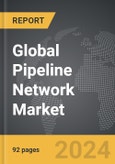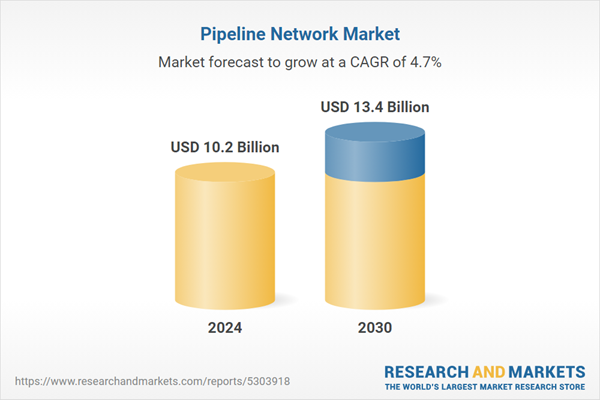The global market for Pipeline Network was valued at US$10.2 Billion in 2024 and is projected to reach US$13.4 Billion by 2030, growing at a CAGR of 4.7% from 2024 to 2030. This comprehensive report provides an in-depth analysis of market trends, drivers, and forecasts, helping you make informed business decisions. The report includes the most recent global tariff developments and how they impact the Pipeline Network market.
Segments: Component (Solutions, Services); Application (Pipeline Monitoring, Pipeline Operation Optimization); End-Use (Crude & Refined Petroleum, Water & Wastewater, Other End-Uses).
Geographic Regions/Countries: World; United States; Canada; Japan; China; Europe (France; Germany; Italy; United Kingdom; Spain; Russia; and Rest of Europe); Asia-Pacific (Australia; India; South Korea; and Rest of Asia-Pacific); Latin America (Argentina; Brazil; Mexico; and Rest of Latin America); Middle East (Iran; Israel; Saudi Arabia; United Arab Emirates; and Rest of Middle East); and Africa.
The analysts continuously track trade developments worldwide, drawing insights from leading global economists and over 200 industry and policy institutions, including think tanks, trade organizations, and national economic advisory bodies. This intelligence is integrated into forecasting models to provide timely, data-driven analysis of emerging risks and opportunities.
Global Pipeline Network Market - Key Trends & Drivers Summarized
What Defines a Pipeline Network and Why Is It Integral to Global Energy Supply?
A pipeline network refers to the interconnected system of pipelines that transport various fluids such as oil, natural gas, water, and refined petroleum products across vast distances. These networks are critical components of global energy infrastructure, ensuring the continuous supply of energy resources from production fields to refineries, distribution hubs, and end consumers. As global energy consumption continues to grow, the role of pipeline networks has become even more pivotal. Pipeline networks are designed to operate with efficiency and minimal environmental disruption compared to other modes of transportation, such as shipping or trucking. In addition, they play a key role in stabilizing energy markets by ensuring that there is a steady flow of essential fuels, even in times of geopolitical tension, natural disasters, or market volatility. For instance, major global pipeline networks such as those in the United States, Russia, and the Middle East provide critical links that stabilize regional and international energy markets. As the energy industry undergoes a significant transformation toward renewable sources, the traditional role of pipeline networks is evolving, necessitating innovations and upgrades to handle new energy carriers like hydrogen and CO2. Understanding the design, operation, and expansion of these networks is crucial for addressing future energy demands and achieving energy security.How Are Technological Advancements Enhancing Pipeline Network Operations?
Technological advancements have significantly transformed how pipeline networks are managed, maintained, and expanded. One of the major breakthroughs is the integration of the Internet of Things (IoT) into pipeline systems, allowing for real-time monitoring of pipeline conditions through a vast array of sensors. These sensors detect parameters such as pressure, temperature, flow rates, and potential leaks, providing operators with data to prevent failures and ensure the continuous operation of pipelines. Digital twins - virtual replicas of physical pipelines - are another innovation allowing operators to simulate different scenarios, analyze stress points, and predict maintenance needs. Artificial intelligence (AI) and machine learning (ML) also play critical roles in automating data analysis and offering predictive maintenance insights. These technologies help operators to identify potential vulnerabilities and address them before they escalate into significant issues. In addition to AI-driven solutions, advanced materials like corrosion-resistant alloys and composite coatings are improving the durability and longevity of pipeline networks, reducing the frequency of repairs. Robots, such as pipeline inspection gauges (PIGs), are being deployed within pipelines to inspect and clean internal surfaces, ensuring smooth operations. These technological advances are not only increasing the efficiency of pipeline networks but also contributing to environmental sustainability by minimizing leaks and spills that could harm ecosystems.What Role Do Emerging Energy Trends Play in Shaping Pipeline Network Development?
The global shift toward clean and renewable energy is having a profound impact on the development and utilization of pipeline networks. While traditional pipelines were primarily designed to transport oil and gas, emerging energy sources such as hydrogen, biofuels, and carbon dioxide (for carbon capture and storage) are now becoming central to pipeline infrastructure planning. Hydrogen, often touted as a future cornerstone of clean energy, presents specific challenges for pipeline networks due to its small molecular size and potential for causing embrittlement in traditional steel pipelines. As a result, many operators are investing in retrofitting existing pipelines or building entirely new ones to accommodate hydrogen transportation. Similarly, the rise of carbon capture, utilization, and storage (CCUS) technology is creating a demand for specialized pipelines that can transport captured CO2 from industrial facilities to underground storage sites. This shift toward handling new forms of energy is influencing not only pipeline design but also regulations and standards, as governments seek to align infrastructure with decarbonization goals. Moreover, the increasing use of liquefied natural gas (LNG) and the need for ultra-cold pipelines to transport LNG is adding a layer of complexity to network development. These energy trends are pushing operators to rethink their infrastructure strategies to ensure that they can meet future energy demands while adhering to environmental commitments.What Factors Are Driving the Growth in the Pipeline Network Market?
The growth in the pipeline network market is driven by several factors that are shaping the industry’s future. One of the most significant drivers is the rising global demand for energy, which necessitates the expansion of pipeline networks to ensure the efficient and uninterrupted supply of oil, gas, and renewable energy sources. As countries diversify their energy portfolios to include cleaner fuels such as hydrogen and biofuels, there is an increasing need for pipelines capable of transporting these new energy carriers safely and efficiently. Another factor is the aging infrastructure in developed regions such as North America and Europe, where many pipelines have been in service for decades and require significant upgrades or replacements to maintain their operational integrity. Furthermore, the expansion of urbanization and industrial activities in developing regions, particularly in Asia-Pacific and Africa, is driving the demand for new pipelines to meet rising energy consumption. Advances in digital technologies like AI, IoT, and big data analytics are also accelerating the growth of the market by enabling more efficient monitoring, predictive maintenance, and enhanced safety features in pipeline networks. Additionally, stricter environmental regulations and the growing public concern over the environmental impacts of pipeline leaks and spills are pushing operators to invest in more sustainable and secure pipeline technologies. Together, these factors are fueling the development of more advanced, resilient, and adaptive pipeline networks that can cater to the evolving needs of the global energy landscape.Report Scope
The report analyzes the Pipeline Network market, presented in terms of units. The analysis covers the key segments and geographic regions outlined below.Segments: Component (Solutions, Services); Application (Pipeline Monitoring, Pipeline Operation Optimization); End-Use (Crude & Refined Petroleum, Water & Wastewater, Other End-Uses).
Geographic Regions/Countries: World; United States; Canada; Japan; China; Europe (France; Germany; Italy; United Kingdom; Spain; Russia; and Rest of Europe); Asia-Pacific (Australia; India; South Korea; and Rest of Asia-Pacific); Latin America (Argentina; Brazil; Mexico; and Rest of Latin America); Middle East (Iran; Israel; Saudi Arabia; United Arab Emirates; and Rest of Middle East); and Africa.
Key Insights:
- Market Growth: Understand the significant growth trajectory of the Solutions segment, which is expected to reach US$8.7 Billion by 2030 with a CAGR of a 4.4%. The Services segment is also set to grow at 5.2% CAGR over the analysis period.
- Regional Analysis: Gain insights into the U.S. market, valued at $2.7 Billion in 2024, and China, forecasted to grow at an impressive 7.8% CAGR to reach $2.9 Billion by 2030. Discover growth trends in other key regions, including Japan, Canada, Germany, and the Asia-Pacific.
Why You Should Buy This Report:
- Detailed Market Analysis: Access a thorough analysis of the Global Pipeline Network Market, covering all major geographic regions and market segments.
- Competitive Insights: Get an overview of the competitive landscape, including the market presence of major players across different geographies.
- Future Trends and Drivers: Understand the key trends and drivers shaping the future of the Global Pipeline Network Market.
- Actionable Insights: Benefit from actionable insights that can help you identify new revenue opportunities and make strategic business decisions.
Key Questions Answered:
- How is the Global Pipeline Network Market expected to evolve by 2030?
- What are the main drivers and restraints affecting the market?
- Which market segments will grow the most over the forecast period?
- How will market shares for different regions and segments change by 2030?
- Who are the leading players in the market, and what are their prospects?
Report Features:
- Comprehensive Market Data: Independent analysis of annual sales and market forecasts in US$ Million from 2024 to 2030.
- In-Depth Regional Analysis: Detailed insights into key markets, including the U.S., China, Japan, Canada, Europe, Asia-Pacific, Latin America, Middle East, and Africa.
- Company Profiles: Coverage of players such as ABB, Emerson, General Electric, Hitachi, Honeywell and more.
- Complimentary Updates: Receive free report updates for one year to keep you informed of the latest market developments.
Some of the 36 companies featured in this Pipeline Network market report include:
- ABB
- Emerson
- General Electric
- Hitachi
- Honeywell
- Huawei
- PSI Software
- Schneider Electric
- Siemens
- Wipro
Tariff Impact Analysis: Key Insights for 2025
Global tariff negotiations across 180+ countries are reshaping supply chains, costs, and competitiveness. This report reflects the latest developments as of April 2025 and incorporates forward-looking insights into the market outlook.The analysts continuously track trade developments worldwide, drawing insights from leading global economists and over 200 industry and policy institutions, including think tanks, trade organizations, and national economic advisory bodies. This intelligence is integrated into forecasting models to provide timely, data-driven analysis of emerging risks and opportunities.
What’s Included in This Edition:
- Tariff-adjusted market forecasts by region and segment
- Analysis of cost and supply chain implications by sourcing and trade exposure
- Strategic insights into geographic shifts
Buyers receive a free July 2025 update with:
- Finalized tariff impacts and new trade agreement effects
- Updated projections reflecting global sourcing and cost shifts
- Expanded country-specific coverage across the industry
Table of Contents
I. METHODOLOGYII. EXECUTIVE SUMMARY2. FOCUS ON SELECT PLAYERSIII. MARKET ANALYSISCANADAITALYSPAINRUSSIAREST OF EUROPESOUTH KOREAREST OF ASIA-PACIFICARGENTINABRAZILMEXICOREST OF LATIN AMERICAIRANISRAELSAUDI ARABIAUNITED ARAB EMIRATESREST OF MIDDLE EASTIV. COMPETITION
1. MARKET OVERVIEW
3. MARKET TRENDS & DRIVERS
4. GLOBAL MARKET PERSPECTIVE
UNITED STATES
JAPAN
CHINA
EUROPE
FRANCE
GERMANY
UNITED KINGDOM
ASIA-PACIFIC
AUSTRALIA
INDIA
LATIN AMERICA
MIDDLE EAST
AFRICA
Companies Mentioned (Partial List)
A selection of companies mentioned in this report includes, but is not limited to:
- ABB
- Emerson
- General Electric
- Hitachi
- Honeywell
- Huawei
- PSI Software
- Schneider Electric
- Siemens
- Wipro
Table Information
| Report Attribute | Details |
|---|---|
| No. of Pages | 92 |
| Published | April 2025 |
| Forecast Period | 2024 - 2030 |
| Estimated Market Value ( USD | $ 10.2 Billion |
| Forecasted Market Value ( USD | $ 13.4 Billion |
| Compound Annual Growth Rate | 4.7% |
| Regions Covered | Global |









